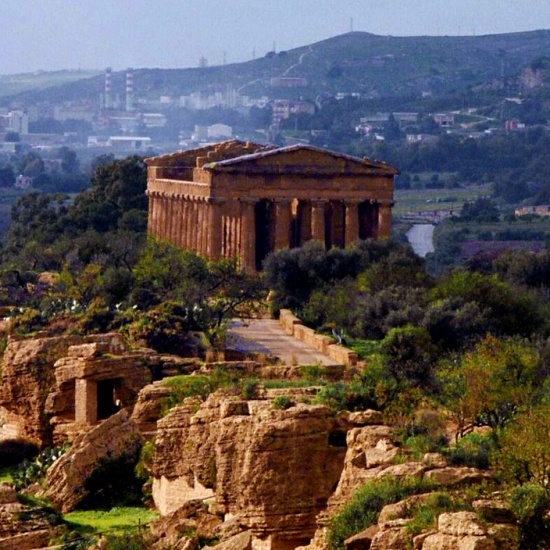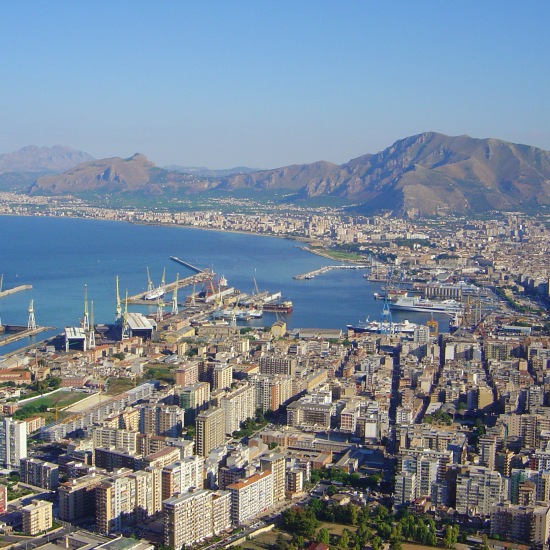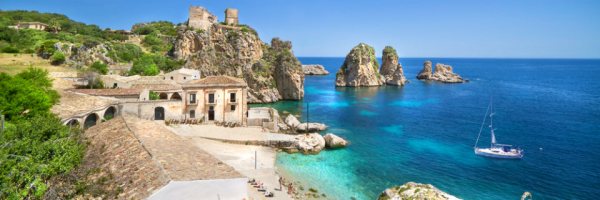
My bible for travel to Italy is an out of print book by Pauline Frommer, “Italy, Spend Less See More. This is what she writes for the tourist who plans to tour Sicily for more than a week:
“Divide your time between Palermo and the eastern coast of Sicily, and add a day or two on the Aeolian islands, the volcanic archipelago just off the north eastern coast of Sicily, and one of Italy’s best kept secrets- for now-offering everything from watersports to beach combing for volcano tours. Any one visiting Sicily should also try to fit in the Roman mosaics at Piazza Armenia (central Sicily) and the Greek ruins at the Temples (Agrigento, southern Sicily). If you’ve got two weeks, you can either add in western Sicily (Erice and the Greek sites of Segesta and Selinunte), or give the sightseeing warpath a rest and just relax in a smaller, more rural part of the island.”

“While staying in Palermo, Pauline Frommer suggests day trips for the tourist, to the fishing village of Cefalu and/ or the Valley of the Temples near Agrigento.”
She suggests the following for those exploring the eastern part of Sicily:
“Divide your time between Siracusa (try to stay in the city’s charming old center, Ortygia island) and Taormina, and plan on a half day excursion to Mt. Etna in there somewhere. You can also leave the island from Catania.”
Ms. Frommer states that her preferred way to travel within Sicily is by car. The alternate option is to go by bus. This is what she writes:
“Driving in Sicily is a pleasure and my personal recommendation for getting around. The distances are never great, the island is easy to navigate, traffic is light outside Palermo, and parking is rarely a problem. What’s more, you’ll be cruising some of the country’s best highways, thanks to the organized- crime syndicates that reportedly dominate public works contracts. You’ll save big bucks by renting from such Italian companies as Maggiore (www. maggiore.it) or Sicily by Car (www.sbc.it.)”

My thinking has now evolved to where I am thinking about staying for up to one week in Palermo with possible side trips to Agrigento, Erice and Cefalu; followed up by a two night stay at the Aeolian islands with a subsequent five day stay in Taormina and then, one night in Catania. Somehow, I would like to also do day side tours to MT. Etna and Siracusa (Syracuse). I am considering renting a car through an Italian rental car company for any touring outside of the city of Palermo. I am leaning towards riding on an overnight train carriage from Rome to Palermo and then taking an overnight compartment on a ferry from Catania to Naples. At this point, I am still open to all options.

The next step is for me to start collecting information about the destinations I am planning to explore. The following historical background regarding Sicily is from Pauline Frommer’s book on Italy:
“Sicily’s tenuous position—strung between North Africa and the European mainland, just 100 miles from Cape Bon in Tunisia and 2 miles from Calabria, Italy on the other—has made it a natural stepping stone for invaders throughout its long history. The earliest- known inhabitants were the Sicanians, who most likely came from somewhere in the eastern Mediterranean in the 3rd millennium B.C. A Latin people called the Sikels arrived around 1200 B.C., and the Elymians from Asia Minor came to the island 1100 B.C. The merging of these three early peoples formed the basis for the uniquely Sicilian ethnicity; it was added to, of course, over the next 3,000 years.

“Sicily’s Hellenistic cities—Siracusa, Catania, and Messina—were founded in the 6th through 8th centuries B.C. by the Greeks, who later built vast temples all over the island, which still stand at Agrigento, Segesta, and Selinunte. Throughout the 4th and 5th centuries B.C., the Carthaginians of north Africa fought the Greeks—and later the Romans—for control and turned the island into a bloody battlefield. After the fall of Rome, Sicily underwent many occupations before returning to the Arabs, or Saracens, in the 9th century, when Islam became the official religion. The Arab rulers tolerated Christianity and Judaism on Sicily.”
“When the Normans wrested control of the island from the Saracens in the 11th century, Sicily began its golden age, throughout which its ancient Greek, Arab and Byzantine influences would blend together and eventually define so much of its character. Sicily fell to the French in the 13th century and was repeatedly sacked and oppressed for the next several hundred years. The Sicilians eventually reacted to this oppression by forming their own secret society, which they called Mafia, a term derived from the Arabic word for “refuge.” In the 1700s, this secret society, by then also known as the Cosa Nostra (“our thing”), began distributing a picture of a black hand as a formal request for protection money. Those who didn’t pay faced misfortune. (The Cosa Nortra is still very much a force in Sicily, though it’s unlikely you’ll be aware of its presence.)”

“By the 19th century, Sicily and Naples formed a sovereign kingdom called the “Two Sicilies,” which unified with Italy in 1861.”
“Today Sicily exists primarily as an agricultural region, its economy heavily subsidized by tourism and profits manipulated by an ever-efficient Mafia. Efforts to turn the region into a mini–Silicon Valley are beginning to see results, and a growing premier wine industry is starting to get international attention.”
“One delight in visiting Sicily is viewing in many pasts, one layer upon the other. Phoenician ruins on the western coast (now anchored by modern-day Palermo) sit below Norman-Arab castles. In Siracusa (Syracuse), a splendid baroque cathedral lies directly on top of a Greek temple. And in Carleone, the hill town and real life Mafia stronghold that inspired the name of the famous “Godfather” character, the main bus terminus is on Piazza delle Vittime della Mafia (Mafia Victims’ Square).”

The following is how Pauline Frommer describes Sicily’s lay of the land in her guidebook:
“The Greeks called Sicily, “Trinacria,” which means three apexes, for the isosceles triangle shape of the island. It’s the largest island in the Mediterranean, surrounded by three seas, the Ionian (to the east), the Tyrrhenian (to the north) and the Mediterranean (to the south), each of which gives the island a different character. Sicily also has several smaller islands off its shores: The Aeolians are to the northeast, the Egadi are to the west, and exotic Pantelleria is to the southwest.”
“For your first visit to Sicily, traveling around the coast is more rewarding than attempting the mountainous and largely rural interior. The towns or attractions I encourage you not to miss are Palermo, Cefalu, to the north; Taormina, Mt. Etna, and Siracusa (Syracuse), to the east; and the temples in Agrigento, to the south.”
Reblogged this on It Is What It Is and commented:
Pre-planning future adventures continue … it will be awesome!!
LikeLike
GRAZIE MILLE!!! I cannot thank you enough for your support. Yes, I and my friend are signing up for a 3 week tour to Costa Rica through OAT, Overseas Adventure Travel.
LikeLiked by 1 person
Always dear friend … happy travels!!
LikeLike
I really have to get to Sicily next! Lovely post 😀 Happy planning!
LikeLike
Thanks for your kind words. I and my friend have been talking about this for years. We are finally going for it.
LikeLike